Traveling through Germany
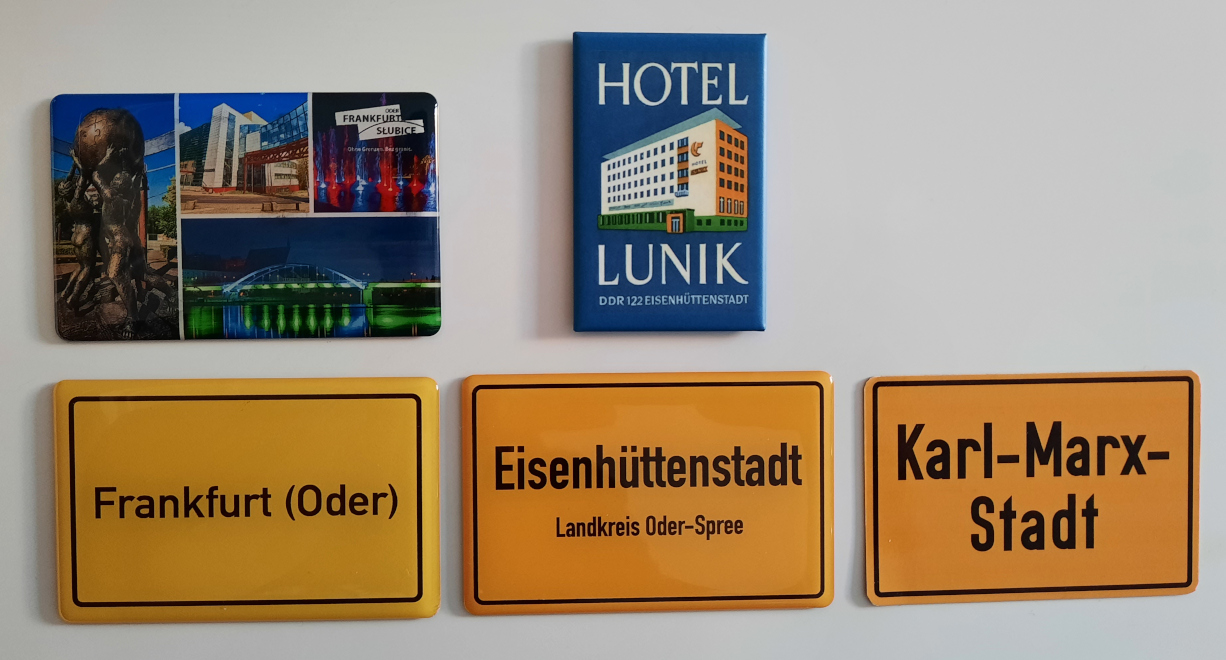 Continue reading for the good story behind the Karl-Marx-Stadt magnet.
Continue reading for the good story behind the Karl-Marx-Stadt magnet.
I went on a trip through Germany together with a long time friend, Rik.
We wanted to visit some cities of the former East Germany (DDR) and look at what had remained from that era in the present day. “large-panel-system building” aka Plattenbau in Germany is still quite widespread in existence. And visit some interesting museums while there. And afterwards attend the Gulaschprogrammiernacht (GPN) 23 in Karlsruhe.
We planned some parts of the trip in advance, but it was largely based on browsing Wikivoyage and Atlas Obscura during the trip for the respective cities we wanted to visit.
The cities we went to, in chronological order:
- Berlin
- Frankfurt (Oder) and adjacent Słubice
- Bytnica, Poland (only the train station)
- Eisenhuttenstadt
- Cottbus
- Dresden
- Zwickau
- Karlsruhe
Berlin: a quick stop
Rik went already two days before me, but this blog is written from my perspective. I traveled to Berlin using regional German transport, which means transfers in the following cities: Den Haag -> Hengelo -> Rheine -> Hannover -> Wolfsburg -> Stendal -> Berlin. I expected the Volkswagen factory in Wolfsberg to be big, but not that big. The train took a couple of minutes to drive past it.
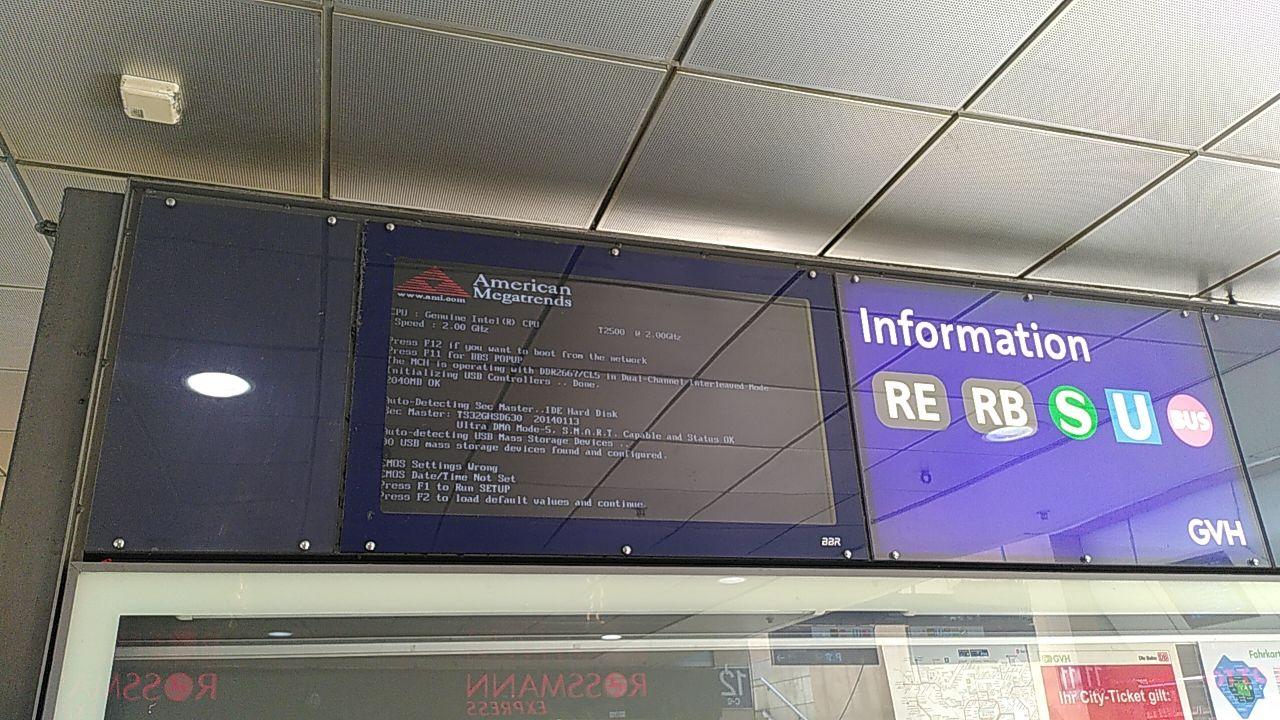 Found some broken stuff on my way at Hannover Hbf.
Found some broken stuff on my way at Hannover Hbf.
After arriving in Berlin Hbf a bit over 20:00, we went to the hotel to drop the luggage. We went downstairs and realized we forgot our keycard, so we got a backup card. Interestingly, the backup card only allowed for a single door unlock.
We got dinner at the Volkskammer, very nicely dectorated restaurant with DDR stuff. If you like that stuff, strongly recommended. Article about it: https://www.moz.de/nachrichten/brandenburg/ddr-geschichte-in-berlin-restaurant-fuer-ost-fans-essen-in-der-volkskammer-77366538.html
Frankfurt (Oder) and Słubice: monuments
The next morning we went to Frankfurt (Oder). First we went to some train monument, then to the Soviet memorial. At the tourist point we got some magnets. We took a walk next to the river past the Friendship Bell and then walked across the bridge, into Poland! Just over the border there was the Wikipedia Monument. I knew the monument existed, but I did not realize it was there until I looked at the Wikivoyage page on the day itself. There was also a CCC next to the monument but not the one you’re thinking of if you know me. Then we got some excellent pierogi.
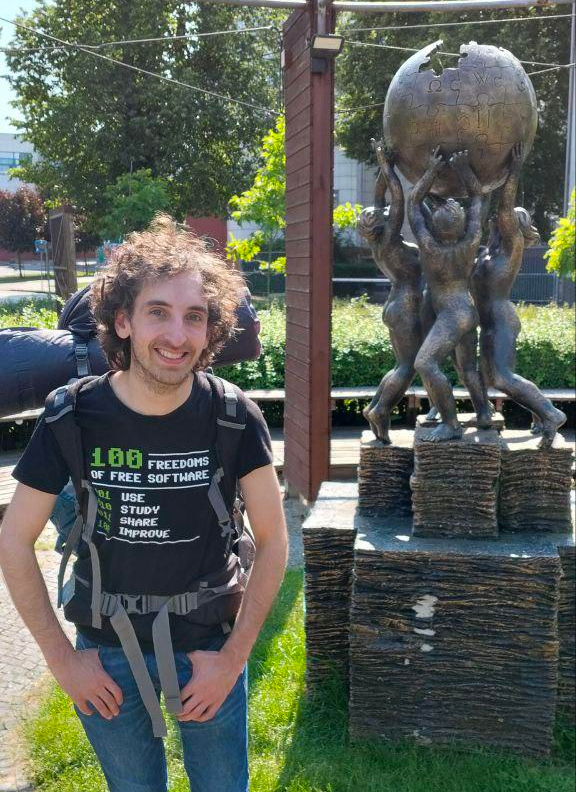 The tourist info point told us that there is a lookout point inside the university building. We tried accessing the tower from multiple different angles from inside of the building but were ultimately told by someone from there that it is not publicly accessible. Bummer! But it was fun seeing a random university from inside anyway.
The tourist info point told us that there is a lookout point inside the university building. We tried accessing the tower from multiple different angles from inside of the building but were ultimately told by someone from there that it is not publicly accessible. Bummer! But it was fun seeing a random university from inside anyway.
Then we went to the Intermarché Super (apparently those exist in Poland!) and got some water for the next day since we were planning to go wild camping without access to fresh water.
Bytnica, Poland: wild camping
The government of Poland has a map website that shows the areas designated for wild camping. When you open the page, you get greeted with the following popup:

Well, that is fun! If you get accused of camping illegally you can’t even point them to this gov.pl website. Whatever, we just went on to camp in one of the areas marked as such on there.
Initially we decided to go wild camping near Rzepin, which was at least a 40 minute walk from the Rzepin station.
It was impossible to buy a railway ticket to the Rzepin station. The reason is still unclear to me, if any railway nerds know, tell me! However, it was possible to buy a ticket in the DB app to the end station of the same railway line, which was Zielona Gora. Because we now had a ticket for a further station, Rik convinced me to check the wild camping map again to see if another station was closer than 40 minutes walking to a wild camping area. And indeed, there was such an area, right next to the Bytnica railway station.
When we entered the train we discovered you could buy tickets from the conductor. I guess that prevents people from complaining hard enough to DB that their systems are broken.
After we arrived at the Bytnica station we walked into the forest. Two guys in a car came at high speed drifting towards us, in a (surely tuned) Fiat Seicento. I was scared for a second, but we survived.
We then setup our tents and made a walk around the lake, which was quite nice! We found a sign lying on the ground that was already there for a decade or so, it was barely readable. A day later we put the text into Google Translate: “No access during the breeding season”. No idea why you’d remove such a sign in a nature area.
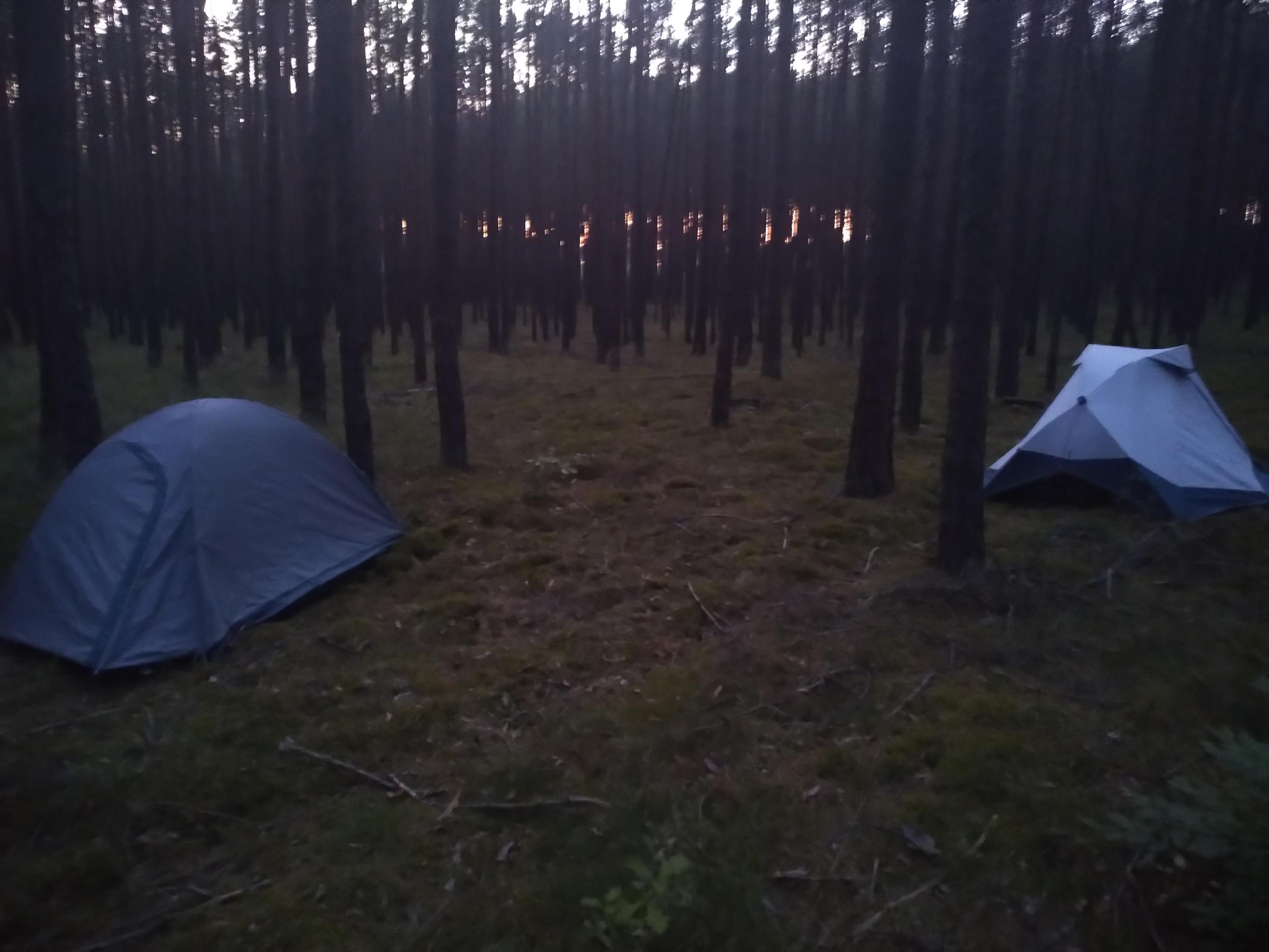
Some sounds we heard in the forest were totally unrecognisable, I regret not making some audio recordings. The lake had a LOT of frogs. (camping recommendation for famfo!)
The station and our tents were close to a sawmill, which kept us up a bit at night.
The train schedule the next morning had a train at 07:08 and the next one at around 10:30. We decided to take the early train to be earlier in Eisenhüttenstadt.
We were a bit slow with packing our tent and underestimated the walking distance. When we were almost at the station, we saw the train entering. Rik ran before me to the train and blocked the train door with his leg. The conductor shouted something in Polish, while the train driver was laughing. My tent poles fell from my backpack and I continued running with those in my hand. I do not recommend running with a heavy backpack and a backpack on your chest plus the tent poles under that level of stress. Inside the train I repacked my bag and bought the ticket. It was now a few euros cheaper because we bought a ticket from the correct station.
The train to Eisenhüttenstadt was canceled so had to wait an hour for next one.
Eisenhüttenstadt: DDR architecture
Once in Eisenhüttenstadt we went to the tourist information which recommended us to go to the library. Then we discovered that the library building had two separate entrances, each with a lift but one of those lifts only went to the first floor and the other one to the 3rd floor, where the libary was. Weird.
We found some cool books about the city itself, including a photo album scrapbook with pictures from the city.
We went to the Dokumentationszentrum Alltagskultur der DDR, which had a nice collection of items. Even an entire telephone cell! Some other telephone I saw looked virtually identical to the Ericsson T65. https://www.ddr-museum.de/en/objects/1021834
Cloning of Western hardware was commonplace, read more about that here: https://en.wikipedia.org/wiki/History_of_computer_hardware_in_Eastern_Bloc_countries
We did some exploring in an abandoned area, which was fun.
In the evening we went to Restaurant Aktivist, which had the most ridiculously fancy looking chairs I have ever sat on in a restaurant. And the restaurant had a robot for delivering food, apparently an innovation introduced because of corona and still in use. I forgot to take a picture of the restaurant, but you can see this picture from Tripadvisor.
Cottbus: airplanes
During the evening we went to Cottbus. The camping near the city was basically a parking area with no reception. There were a few shipping containers on the field. Weirdest “camping” I have been to so far.
The next day we went to the city center and explored the Wendisch Viertel with some more decorated Plattenbau.
The airplane museum we then went to is located next to the former military airport of Cottbus. Definetely an interesting collection of stuff. Not only airplanes, but also radar systems. Inside, various rooms were dedicated to specific parts of the plane. There was one room dedicated to ejection seats for example.
We both got a patch from the museum shop, dedicated to the last flight of the Tupolev Tu-134A to the museum which happened in 2017.
When we left the museum and went to a nearby bus stop, we discovered that it was a call bus, that you had to call for on the day before. Ugh. So we walked back to another line and were delayed by an hour or so.
Dresden: history of cameras, computers and the military
We had booked the A&O hostel in Dresden, but apparently the reservation expired at 18:00 and we arrived after 19:00. Luckily, it only was a guarantee of a reservation and the room was still free. We got a random upgrade to a family room, nice!
Got a drink on the roof terrace, which had quite a nice view over the city. Then we went to the Chaos Computer Club Dresden. Usually hackerspaces don’t have the most visible entrance from the street level, but these folks had the genius idea of putting a GIF on their website that showed how you had to walk to the door from the street level.
We got a tour through the space, they had quite nice equipment. And of course I had a Mate. Did some soldering work on my Hacker Jeopardy buttons.
The next day we went to the Technische Sammlungen Dresden. Lots of cameras and computers. They had an escape tour, which we did. We had to collect enough points to let Schrödingers cat escape alive. We lost against the other teams, but all together we collected enough points.
We went on a search to find if the former headquarters of Robotron still exists. It’s not on Google Maps under that name since it is now a business complex. But it was not that hard to find since the Wikipedia photo of the headquarters had coordinates in the metadata: https://en.wikipedia.org/wiki/VEB_Robotron#/media/File:VEB_Kombinat_Robotron_Dresden_1990.jpg
The building is still standing! There is even a Robotron logo visible on a sign at the floor level, although the big logo on the top of the building was no longer there. The frame to which the logo was originally attached is still there though.
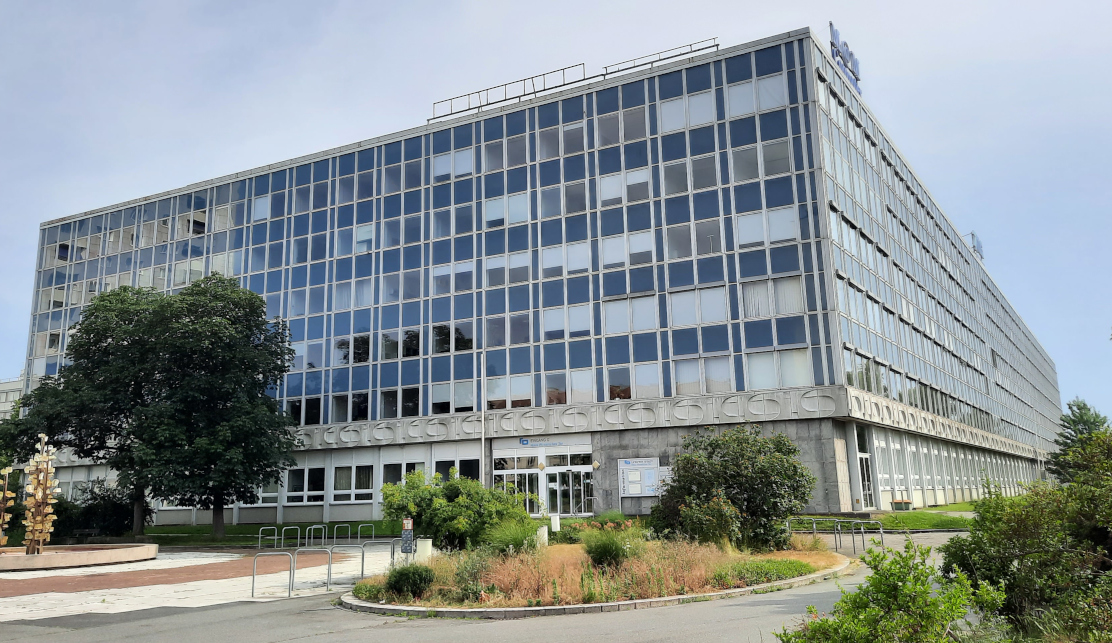
The WWII bombings are a central part in the history of Dresden. Before coming there, I expected more of a Rotterdam vibe, with modernist architecture. But to my surprise, the city center is full of historicist architecture. They did rebuild a lot of the stuff, quite impressive.
The DDR-era Kulturpalast is still standing there as well, which has some similarities to the now-demolished Palast der Republik.
Chemnitz: Karl Marx and more
First we went to the Stadthalle Chemnitz. It was closed for visitors, but there was a guy who was brining some stuff into the hall, to prepare something. He allowed us to take a look inside. It looked great! There was a cool artwork on the wall.
Then we went to the statue of Karl Marx. I like that they kept it after renaming the city back to its historical name.
Many museums were closed on the day we arrived unfortunately, but the motor museum was still open. Not a big museum, but ran by some passionate collectors! I prefer this type of museum.
Rik talked a bit to a mathematics professor during a bus ride, who told us she found the former name of the city stupid, because Karl Marx never even visited the city. (tl;dr he studied in Jena and lived in Paris, Brussels and London).
Later we went to look at some plattenbau architecture away from the center.
On the way back to the city center we walked through the garden of Villa Esche. Unfortunately it was already closed for the day, but the outside was definitely worth seeing. It has quite an interesting history of being used as a Soviet command post, then a Stasi office, then some educational building and is now a museum.
We wanted to get another one of the Ortstafel fridge magnet for the city, preferably the former name of the city (because it’s a fun name). We looked at multiple tourist shops, but to our surprise, none had them. Then we found a photo shop, which printed custom magnets! We went to a cafe and I opened Inkscape on my laptop. I took the sign from Wikipedia and changed the aspect ratio. Unfortunately the shop closed in the meantime, but I mailed the rendered PNG to her and we got our magnet the next morning. Awesome, a custom souvenir! I saw on her desk that she printed a bunch more, so I guess we created some new business.
Zwickau: Car museum
When leaving Chemnitz after we got our magnets, we took the train to Zwickau to visit the August Horch Museum. Excellent collection of cars. An a whole exhibition dedicated to the Trabant. Would recommend!
We wanted to take the bus back to the station, but the bus stop was moved to a place that was not clearly stated. So we walked back to the station.
Some person in the train was reading their book, the conductor was looking funny at us when he waved in front of the person without them noticing it. Looking at the sunset in the countryside from a train that had open windows was great. 10/10 holiday feeling.
We got out of the station once more in Heilbronn to get dinner. Our plan was to go to Hans im Glück, but the kitchen was already closed when we arrived. So we got döner near the station, which was fine. They were disassembling the price list from the wall during our visit.
Karlsruhe: Camping Durlach and GPN
Like last year, we went camping at Campingplatz Durlach, but now with four people instead of two. Rik and I arrived later, and apparently I forgot to click on the confirmation link for the reservation so they had to re-do all the stuff. Sorry famfo and jn! For the camping personnel it was also highly unusual to deal with people who arrive by foot. They include a parking spot by default, which you then have to request to be removed from the order. Annoying.
We setup our tents and went to GPN the next day. Yay! First day was already great, meeting old friends and people that I only spoke with online before. There are still some people that I forgot to meet, unfortunately.
On the second day, Hacker Jeopardy was scheduled. Oh boy. I had to fix the firmware and hardware in time. Spoiler: I did not manage to, but I hosted the game anyway. To me it felt like a failure, but apparently failing hardware is a tradition at the CCCongress Hacker Jeopardy, so accidentally I followed their tradition. Many people told me afterwards they greatly enjoyed it, so I can consider it a success after all.
You can see the Hacker Jeopardy questions and answers for yourself here, round 1 and round 2.
There will be Hacker Jeopardy again at WHY and at eth0:2025, stay tuned.
On Saturday, Linus helped me with implementing the first part of WebUSB in his JavaScript engine. It did actually work! :D
On Sunday I did an improvised lightning talk based on my earlier blog on fedi instances. After GPN ended that day we got pizza at American Pizza California. They had a “Pizza Greece”, so I obviously took that one.
We left from Camping Durlach on Monday morning and I made a stop at CCCAC in Aachen, and printed my “Hack hier” sticker for their wall and had a Krombacher Spezi.
Then I went home, finally.
Deutschlandticket on paper
We did the entire trip by Deutschlandticket, apart from the Dutch travel and a small train journey in Poland. It is really nice that you can just take any (local) transit at any time without having to buy separate tickets. And not having ICE speeds wasn’t really an issue.
After trying multipe apps and websites without result, I booked it on the 10th of the month in the VVR app and directly cancelled it (so I only have to pay for one month). Since my phone battery isn’t that great, I went looking for a way to print the e-ticket. Being frustrated I could not find such an option, I printed a screenshot with the Aztec code on it. I posted about it on fedi and learned from multiple people that a printed D-Ticket is not actually a valid ticket because the relevant German law explicitly specifies it needs to be digital. Q told me a screenshot outside of the app should also be valid. Anyway, I just wanted to attempt if conductors would accept a paper ticket. All of them did, except one on the Dresden S-Bahn so I showed him the app. If you fear that your battery will get empty, I can recommend this as a mostly fine fallback option.